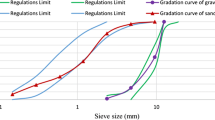Abstract
The consolidation behaviour of fresh cementitious materials is a key factor that governs water-retaining ability of concrete and therefore its bleeding behaviour. Moreover, consolidation theory provides a tool able to predict the heterogeneous W/C (water to cement mass ratio) profile within formwork. Recent studies have shown that bleeding rate of cement-based materials is controlled by the material permeability and the amount of available free water, which can be computed using concrete compressibility. Both parameters can be combined to compute the consolidation coefficient, which describes the whole consolidation process. The aim of this study is to describe the effect of mix-design parameters, such as aggregates volume fraction, water reducing admixture and two fillers, on the consolidation behaviour of fresh cement-based materials. The evolution of both permeability and compressibility of concrete for the three studied mix design parameters are given in this paper.










Similar content being viewed by others
References
Terzaghi K, Peck RB, Mesri G (1996) Soil mechanics in engineering practice, 3rd edn. Wiley, New York
Morris PH, Dux PF (2010) Analytical solutions for bleeding of concrete due to consolidation. Cem Concr Res 40:1531–1540
de Josserand L, Larrard F (2004) A method for concrete bleeding measurement. Mater Struct 37:666–670
Assaad JJ, Harb J (2011) Surface settlement of cementitious-based materials determined by oedometer testing. Mater Struct 44:845–856
Yim JY, Kim JH, Kwak HY, Kim JK (2013) Evaluation of internal bleeding in concrete using a self-weight bleeding test. Cem Concr Res 53:18–24
Perrot A, Rangeard D, Mélinge Y (2014) Prediction of the ram extrusion force of cement-based materials. Appl Rheol 24:53320
Powers TC (1968) Properties of fresh concrete. Wiley & Co, New York, p 661
de Josserand L, Larrard F (2004) A method for concrete bleeding measurement. Mater Struct 37:666–670
Perrot A, Lecompte T, Khelifi H, Brumaud C, Hot J, Roussel N (2012) Yield stress and bleeding of fresh cement pastes. Cem Concr Res 42:937–944
Miltiadou-Fezans A, Tassios TP (2013) Stability of hydraulic grouts for masonry strengthening. Mater Struct 46:1631–1652
Ghourchian S, Wyrzykowski M, Lura P (2016) The bleeding test: a simple method for obtaining the permeability and bulk modulus of fresh concrete. Cem Concr Res 89:249–256
Peng Y, de Jacobsen S, Weerdt K, Pedersen B (2013) Model and test methods for stability of cement paste. ASTM Adv Civ Eng Mater 3:1–24
Wainwright PJ, Ait-Aider H (1995) The influence of cement source and slag additions on the bleeding of concrete. Cem Concr Res 25:1445–1456
Khayat KH (1998) Viscosity-enhancing admixtures for cement-based materials—an overview. Cem Concr Compos 20:171–188
Mikanovic N, Jolicoeur C (2008) Influence of superplasticizers on the rheology and stability of limestone and cement pastes. Cem Concr Res 38:907–919
Perrot A, Rangeard D, Picandet D, Mélinge Y (2013) Hydro-mechanical properties of fresh cement pastes containing polycarboxylate superplasticizer. Cem Concr Res 53:221–228
Peng Y, Jacobsen S (2013) Influence of water/cement ratio, admixtures and filler on sedimentation and bleeding of cement paste. Cem Concr Res 53:133–142
Giaccio G, Giovambattista A (1986) Bleeding: evaluation of its effects on concrete behaviour. Mater Struct 19:265–271
Rangeard D, Perrot A, Picandet V, Mélinge Y, Estellé P (2015) Determination of the consolidation coefficient of low compressibility materials. Mater Struct 48:1475–1483
Terzaghi K (1943) Theoretical soil mechanics. Wiley, New York
Tavenas F, Leblond F, Jean P, Leroueil S (1983) The permeability of natural soft clays. Can Geotech J 20:629–660
Carman PC (1956) Flow of gases through porous media. New York Academic, New York
Carman PC (1939) Permeability of saturated sands, soils and clays. J Agric Sci 29:263–273
Chapuis RP, Aubertin M (2003) On the use of the Kozeny–Carman equation to predict the hydraulic conductivity of soils. Can Geotech J 40:618–628
Taylor DW (1948) Fundamentals of soil mechanics. Wiley, New York
Picandet V, Rangeard D, Perrot A, Lecompte T (2011) Permeability measurement of fresh cement paste. Cem Concr Res 41:330–338
Roussel N, Lemaître A, Flatt RJ, Coussot P (2010) Steady state flow of cement suspensions: a micromechanical state of the art. Cem Concr Res 40:77–84
Neale GH, Nader KN (1973) Prediction of transport processes within porous media: diffusive flow processes within an homogeneous swarm of particles. Am Inst Chem Eng J 19:112–119
Perrot A, Rangeard D, Picandet V, Serhal S (2015) Effect of coarse particle volume fraction on hydraulic conductivity of fresh cement based material. Mater Struct 48(7):2291–2297
Hot J, Bessaies-Bey H, Brumaud C, Duc M, Castella C, Rousse N (2014) Adsorbing polymers and viscosity of cement pastes. Cem Concr Res 63:12–19
Lambe TW, Whitman RV (1969) Soil mechanics. Wiley, New York
Cozzolino EUM (1961) Statistical forecasting of compression index. Proceedings of 5th international conference on soil mechanics and foundation engineering, Paris, vol 1. pp 51–54
Leroueil S, Tavenas F (1983) Propriétés caractéristiques des argiles de l’est du Canada. Can Geotech 20:681–705
Author information
Authors and Affiliations
Corresponding author
Rights and permissions
About this article
Cite this article
Perrot, A., Rangeard, D. Effects of mix design parameters on consolidation behaviour of fresh cement-based materials. Mater Struct 50, 117 (2017). https://doi.org/10.1617/s11527-016-0988-0
Received:
Accepted:
Published:
DOI: https://doi.org/10.1617/s11527-016-0988-0




